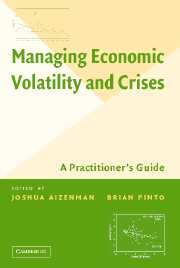Book contents
- Frontmatter
- Contents
- Contributors
- Acknowledgments
- Foreword
- MANAGING ECONOMIC VOLATILITY AND CRISES
- Overview
- PART I WHAT IS VOLATILITY AND WHY DOES IT MATTER?
- PART II COMMODITY PRICES AND VOLATILITY
- 4 Agricultural Commodity Price Volatility
- 5 Managing Oil Booms and Busts in Developing Countries
- PART III FINANCE AND VOLATILITY
- PART IV MANAGING CRISES
- Technical Appendix
- Index
- References
4 - Agricultural Commodity Price Volatility
Published online by Cambridge University Press: 25 July 2009
- Frontmatter
- Contents
- Contributors
- Acknowledgments
- Foreword
- MANAGING ECONOMIC VOLATILITY AND CRISES
- Overview
- PART I WHAT IS VOLATILITY AND WHY DOES IT MATTER?
- PART II COMMODITY PRICES AND VOLATILITY
- 4 Agricultural Commodity Price Volatility
- 5 Managing Oil Booms and Busts in Developing Countries
- PART III FINANCE AND VOLATILITY
- PART IV MANAGING CRISES
- Technical Appendix
- Index
- References
Summary
ABSTRACT: Traded agricultural commodities are an important source of export earnings for many developing countries, and an important component of income and expenditure for poor farmers. Thus, policies to manage the negative consequences of volatile commodity markets are a key issue for governments and policymakers. This study considers the origins, incidence, and consequences of commodity price volatility.
Over the past two decades, both the political institutions that structure the markets for internationally traded commodities and the policies that have emerged from these institutions have changed in dramatic ways. Policies based on government or multilateral interventions that had been common for decades have come to be viewed as ineffective and unsustainable. Policies and supporting institutions that were put in place to foster development have come to be viewed as impediments to growth. Nevertheless, because traded agricultural commodities remain an important source of export earnings for many developing countries and an important component of income and expenditure for poor farmers, policies to manage the negative consequences of volatile commodity markets remain a key issue for governments and policymakers.
This chapter reviews the work of applied economists and policymakers and the institutions that have come to characterize the commodity and risk markets since the 1980s. It discusses how a growing body of work has contributed to a change in thinking that has moved policy away from price and revenue stabilization goals toward policies that emphasize the management of commodity risks. The study illustrates this change in approach with new and sometimes experimental programs, with special emphasis on World Bank programs.
- Type
- Chapter
- Information
- Managing Economic Volatility and CrisesA Practitioner's Guide, pp. 137 - 185Publisher: Cambridge University PressPrint publication year: 2005
References
- 11
- Cited by

